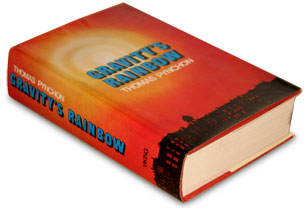|
|
| (49 intermediate revisions by 2 users not shown) |
| Line 1: |
Line 1: |
| − | Connections to Pynchon's wide-spread yet remarkably hidden family history are scattered throughout this masterwork. Well known author and urban legend [http://www.newenglandancestors.org/education/articles/research/special_guests/gary_boyd_roberts/48_659_448.asp Thomas Ruggles Pynchon the Fifth] comes from a long line that begins with William Pynchon, founder of the town of Springfield, Massachusetts. [http://www.picturehistory.com/product/id/4832 Thomas Ruggles Pynchon the Third] is more than a footnote to [http://journals.cambridge.org/action/displayAbstract;jsessionid=5FB21F083E60E4CE450B0320759422AF.tomcat1?fromPage=online&aid=8545 Nathaniel Hawthorne]. This [http://www.vheissu.info/bio/eng_tijdlijn.htm Pynchon Timetable] comes from the [http://www.vheissu.info/index.htm Vheissu] website:
| + | [[File:Book_GR_sm.jpg|350px|thumb|''Gravity's Rainbow''<br />'''Jacket Art:''' [[Marc_Getter_-_Designer_and_Artist|Marc Getter]]<br />'''Publication date:''' Feb 28, 1973|right]] |
| | | | |
| − | :Nathaniel Hawthorne publishes The House of the Seven Gables. Rev. Thomas Ruggles Pynchon (1823-1904) writes the author a letter, complaining about the 'abuse' of the 'Pyncheon' name. This rev. Thomas Ruggles Pynchon will become the ninth president of Trinity College in Hartford, Conn, where he teaches science and religion. In 1881 he publishes an Introduction to Chemical Physics. His brother William is the great-grandfather of author Thomas Pynchon.
| + | ==Cover Art== |
| | | | |
| − | The use of language in his ' [http://books.google.com/books?id=QmdOAAAAMAAJ&pg=RA2-PA16&dq=Thomas+Ruggles+Pynchon+Trinity+college&as_brr=1#PPP1,M1 Introduction to Chemical Physics]' is reminiscent of his namesake:
| + | '''NOTE:''' You can view the many variations of ''Gravity's Rainbow'' cover art through the years at [http://thomaspynchon.com/pynchon-cover-art/gravitys-rainbow/ ThomasPynchon.com] |
| − | | + | |
| − | :"The name Chemistry, is said to be derived from the Arabic word Kimia, something hidden or concealed, and from this, to have been converted into Xyueia*, a word first used by the Greeks about the eleventh century, and meaning the art of making gold and silver. Between the fifth century and the taking of Constantinople in the fifteenth century, says Dr. Thomson, in his History of Chemistry, the Greeks believed in the possibility of making god and silver artificially; and the art which professed to teach the processes was called by them, Chemistry. This idea, however, has long since been thoroughly discarded, and is now no longer heard of."
| + | |
| − | | + | |
| − | Like the author we are discussing, Thomas Pynchon was a daunting polymath.
| + | |
Latest revision as of 08:16, 30 August 2017

Gravity's RainbowJacket Art: Marc GetterPublication date: Feb 28, 1973
Cover Art
NOTE: You can view the many variations of Gravity's Rainbow cover art through the years at ThomasPynchon.com
